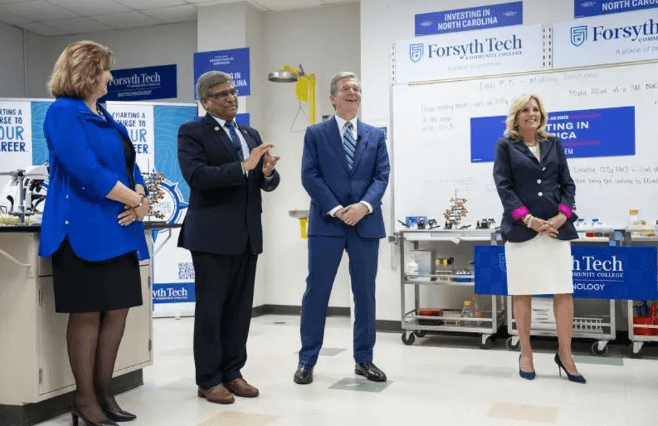白宫为何宣布在社区学院进行最广泛的创新投资

【中美创新时报2024年9月23日编译讯】(记者温友平编译)虽然您可能不会从大多数头条新闻中想到这一点,但 2022 年的 《芯片和科学法案》(CHIPS and Science Act)不仅仅是一项半导体法案。正如众议院科学、空间和技术委员会主席 Frank Lucas (R-Okla.) 众议员所强调的那样,《芯片和科学法案》中的“科学”部分将成为“未来几十年美国经济发展的引擎”。社区学院对经济增长至关重要。《福布斯》记者沙林·乔蒂什(Shalin Jyotishi)对此作了下述报道。
CHIPS 法案是美国工业政策的两党合作、数十亿美元的回报,对 STEM 行业的教育和劳动力发展意义重大。该法案投入了数十亿美元来支撑半导体行业,但它也为重振我们的研发和技术开发基础设施奠定了基础,目标是加速创造就业机会,发展国会在法案中规定的关键新兴技术领域的战略性产业。
CHIPS 对国家如何资助研发、如何将研发转化为经济增长和创造就业机会以及如何协调技术和人才发展具有重大影响。
研究型大学是支持这一目标的关键参与者,但社区学院也越来越被认可在创新经济中发挥着关键作用。
首先,许多由技术投资产生的工作将是中等技能工作,需要的学历不低于高中教育水平,但低于学士学位。社区和技术学院在提供负担得起的劳动力发展计划方面处于高等教育领域的领先地位,包括学徒制、证书、行业颁发的证书准备、新兵训练营和其他形式的定制培训。社区学院水平的学士学位在美国近一半的州都有提供,这些学位涉及生物制造和应用人工智能等领域。
因此,社区学院已经超越了其根基,支持实施 CHIPS——不仅仅是为半导体工作做准备——还包括构成未来工作和与之相关的工作技能——人工智能、自动驾驶汽车、量子计算、生物技术、绿色能源工作、先进制造业等领域的工作。
其次,社区和技术学院通往创新经济的道路可以帮助确保未来的技术劳动力更像美国,而不是硅谷——白人、男性和富人。当开发和部署人工智能等新兴技术的员工不能反映使用这些技术的社区时,性别、种族、年龄、宗教和阶级之间的有害系统性偏见就会融入到这些技术的设计中。
这对科技公司和消费者来说是双输的。社区大学招收了大量少数族裔、第一代大学生和工薪阶层美国人——这些人的观点和态度在新技术中反映得最少。白宫已经与社区大学合作试行“红队”人工智能——对大型学习模块进行反复测试,看看它们是否会使系统产生不良输出或以其他方式失败,目的是更好地了解这些系统带来的风险。
除了代表性之外,社区大学还可以确保美国农村地区不被抛在后面。农村社区大学在为农村社区提供当地可获得的劳动力教育方面发挥着关键作用。他们招收的学生群体比大学更像美国,其中包括大量工薪阶层美国人,他们通常不会从纽约市、硅谷或马萨诸塞州波士顿等传统热点地区的技术繁荣中受益。
该法案“科学”部分的一个重要贡献是美国国家科学基金会 (NSF) 设立了技术、创新和伙伴关系 (TIP) 理事会。TIP 理事会是 NSF 三十多年来的第一个新机构。它专注于资助应用研究、技术转让、初创企业孵化和劳动力发展,以创造以先进或新兴技术为基础的新产业和新工作。
NSF TIP 理事会的标志性项目是其区域创新引擎计划——这是现代对区域科学和技术创新能力最广泛、最重要的投资之一。
NSF 引擎是一个基于科学和技术的经济发展计划。引擎是研究型大学、经济发展组织、雇主、初创企业孵化器、社区学院、工会和劳动力利益相关者的联合体。他们正在联手将他们的地区打造成新兴技术研究、开发和创造就业机会的中心。
这是自亚伯拉罕·林肯在内战高峰期签署《莫里尔法案》并创建赠地大学以来,对区域科学和技术创新能力最广泛、最实质性的投资。
1 月,NSF 主任 Sethuraman Panchanathan 宣布了首个引擎——不是在精英常春藤联盟研究型大学——而是在福赛斯技术社区学院,第一夫人吉尔·拜登本人也是一名社区学院教授。所有十个 NSF 引擎都包括社区学院作为指定合作伙伴。在 6 月由 New America 主办的一场活动上,Panchanathan 强调了社区学院在为新兴职业培养熟练技术劳动力方面的核心地位。
NSF 引擎及其在美国经济发展管理局的姊妹项目——区域技术和创新中心或“技术中心”计划(也以社区学院的大量作用为特色)可以帮助实现为更多美国人提供创新经济良好工作的承诺。两项 CHIPS 法案投资都旨在将新兴技术与人才发展结合起来。
自 2022 年 3 月成立以来,NSF 30 多年来的第一个新理事会就强调需要投资于社区学院针对新兴技术需求的劳动力培训和能力建设。NSF-TIP 启动了两项资助计划,即促进伙伴关系以提高创新能力 (EPIIC) 和新兴和新技术体验式学习 (ExLENT),为社区学院的这两种活动提供资金。
这些计划和其他类似计划帮助 NSF 和美国社区学院朝着更全面参与区域创新生态系统的方向发展。
NSF 还有很多工作要做,才能实现其通过社区学院为新兴产业培养强大、熟练的技术劳动力的愿景。一些学院报告称,它们是强大研究型大学的“纸上合作伙伴”。在 2023 年 10 月 6 日由 New America 主办的网络研讨会上,一位与会者向 NSF 提出了一个问题,他表示,尽管该机构呼吁将“强大的大学”纳入 NSF Engines 等计划,但“强大的大学”正在排挤潜在的社区和技术学院合作伙伴。
此外,国会尚未完全拨出 CHIPS 与科学法案的资金。3 月,国会拨款委员会将 NSF 的预算削减了 8 亿美元,而不是将其增加到法案授权中提出的水平。社区学院公开反对削减预算,并与企业、大学和科学协会一起敦促拨款委员会全额资助该机构。
但由于 CHIPS 法案和 NSF 的后续行动,通过社区学院获得创新经济中更公平的就业机会似乎已成定局。
题图:NSF 推动 CHIPS 法案在 Forsyth Tech 社区学院启动。白宫和美国国家科学基金会宣布了具有历史意义的 NSF 区域(美国国家科学基金会)
附原英文报道:
Why The White House Announced Its Broadest Innovation Investment At A Community College
by Shalin Jyotishi Forbes,Updated Sep 23, 2024
NSF Engines CHIPS Act Launch at Forsyth Tech Community College
The White House and the U.S. National Science Foundation announced the historic NSF Regional … [+]U.S. National Science Foundation
While you may not think it from most headlines, the CHIPS and Science Act of 2022 was more than a semiconductor bill. As emphasized by Rep. Frank Lucas (R-Okla.), chair of the House Committee on Science, Space, and Technology, the “science” portion of the CHIPS and Science Act will be “the engine of America’s economic development for decades to come.” Community colleges are critical to that economic growth.
The CHIPS Act was a bipartisan, multi-billion dollar return of American industrial policy and a big deal for education and workforce development across STEM industries. The legislation funneled billions into shoring up the semiconductor industry, but it also set the stage to reinvigorate our R&D and technology development infrastructure with the goal of accelerating job creation and growing strategic industries in key emerging technology areas Congress enshrined in the bill.
CHIPS has major implications for how the nation funds research and development, how that R&D gets translated into economic growth and job creation, and how we can align technology and talent development.
Research universities are key players in supporting this goal, but community colleges are also increasingly recognized as playing a key role in the innovation economy.
First, many jobs resulting from technology investments will be middle-skill jobs that require more than a high school education but less than a bachelor’s degree. Community and technical colleges lead the postsecondary education sector in offering affordable workforce development programs, including apprenticeships, certificates, preparation for industry-awarded certifications, boot camps, and other forms of customized training. Community college-level bachelor’s degrees, which are offered in nearly half of U.S. states, have been launched in areas like biomanufacturing and applied artificial intelligence.
As a result, community colleges have expanded beyond their roots to support the implementation of CHIPS–not just for career preparation for semiconductor jobs–but for jobs skills comprising and adjacent to the future of work–jobs in artificial intelligence, autonomous vehicles, quantum computing, biotechnology, green energy jobs, advanced manufacturing, and beyond.
Second, community and technical college pathways to the innovation economy can help ensure that the technology workforce of tomorrow looks more like America and less like Silicon Valley–white, male, and affluent. Harmful systemic biases across gender, race, age, religion, and class get baked into the design of emerging technologies like AI when the workforce developing and deploying them isn’t reflective of communities using them.
That’s a lose-lose for technology companies and consumers. Community colleges enroll a large share of racial minorities, first-generation college-goers, and working-class Americans – people whose views and attitudes are reflected least often in new tech. Already, the White House has piloted working with community colleges for “red-teaming” AI–poking and prodding large learning modules to see if they could make the systems produce undesirable outputs or otherwise fail, with the goal of better understanding the risks that these systems present.
Beyond representation, community colleges can ensure rural America isn’t left behind. Rural community colleges play a critical role in offering locally accessible workforce education in rural communities. They enroll a student population that looks a lot more like America than universities, including the large share of working-class Americans that don’t normally benefit from technology booms in traditional hot spots like New York City, Silicon Valley, or Boston, Massachusetts.
An important contribution of the “science” part of the Act was the establishment of the Technology, Innovation, and Partnerships (TIP) Directorate at the U.S. National Science Foundation (NSF). The TIP Directorate was NSF’s first new arm in over thirty years. It’s focused on funding applied research, technology transfer, startup incubation, and workforce development needed to create new industries and jobs rooted in advanced or emerging technologies.
A signature program of NSF’s TIP directorate is its Regional Innovation Engines program–which represents one of the broadest and most significant investments in regional science and technology innovation capacity in the modern era.
NSF Engines is a science- and technology-based economic development program. Engines are consortiums of research universities, economic development organizations, employers, startup incubators, community colleges, labor unions, and workforce stakeholders. They are teaming up to make their region a hub of emerging technology research, development, and job creation.
It represents the broadest and most substantial investment in regional science and technology innovation capacity since Abraham Lincoln signed the Morrill Act and created land-grant universities at the height of the Civil War.
In January, NSF Director Sethuraman Panchanathan announced the inaugural Engines–not at an elite Ivy League research university–but at Forsyth Technical Community College alongside First Lady Jill Biden, a community college professor herself. All ten NSF Engines include community colleges as named partners. Speaking at an event hosted by New America in June, Panchanathan emphasized the centrality of community colleges in educating the skilled technical workforce for emerging occupations.
NSF Engines along with its sister program in the U.S. Economic Development Administration–the Regional Technology and Innovation Hub or “Tech Hubs” program, which also features a large community college role, could help realize the promise of good jobs in the innovation economy for more Americans. Both CHIPS Act investments aim to align emerging technology and talent development.
Since its inception in March 2022, NSF’s first new directorate in over 30 years emphasized a need to invest in workforce training and capacity building at community colleges specific to emerging technology needs. NSF-TIP launched two grant programs, Enabling Partnerships to Increase Innovation Capacity (EPIIC) and Experiential Learning for Emerging and Novel Technologies (ExLENT), which funded both kinds of activities at community colleges.
These programs and others like it have helped both the NSF and America’s community colleges evolve towards a more comprehensive participation in regional innovation ecosystems.
There’s still much more NSF must do to fulfill its vision of fostering a strong, skilled technical workforce for emerging industries through community colleges. Some colleges report being “on paper partners” to powerful research universities. During an October 6, 2023 webinar hosted by New America, an attendee posed a question to NSF, suggesting that “powerful universities” were nudging out possible community and technical college partners despite the agency’s call to include them in programs like NSF Engines.
Additionally, Congress has yet to fully appropriate funding for the CHIPS & Science Act. In March, Congressional appropriators slashed the budget of the NSF by $800 million rather than increasing it to the levels proposed in the bill’s authorizations. Community colleges have spoken out against the cuts, joining business, universities, and science associations to urge appropriators to fully fund the agency.
But thanks to the CHIPS Act and NSF’s follow through, the table seems set for more equitable access to jobs in the innovation economy through community colleges.

